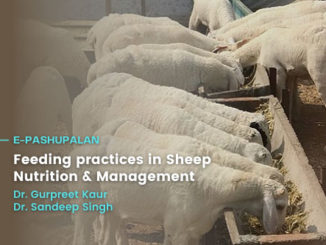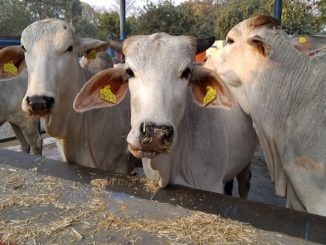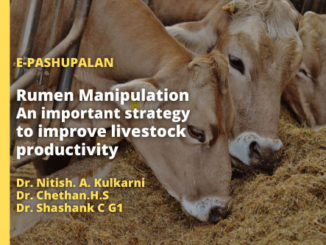Feed pelleting is the process of converting finely ground mash feed into dense, free flowing pellets or capsules using steam injection (moisture and heat) and mechanical pressure. Pelleting technology was developed in the 1930s and is now used in the production of almost all commercial broiler feeds. One of the many advantages of feeding pelleted diets is better bird performance (increased
feed intake, weight gain, and feed conversion). Birds fed pelleted diets spend less time eating and digesting and require less maintenance energy than those fed mash feed. Other advantages of feeding pelleted diets include increased feed density, reduced feed dustiness, wastage, and selection, improved mechanical handling of feed on feed lines, and the eradication of feed-borne diseases. Without pelleted feed, modern broiler strains cannot reach their full genetic potential. To accomplish these multi-benefits, the pellet durability should be of standard quality (no excessive fineness), else the bird’s performance would suffer.
How is pelleting done
Pelleting involves conditioning raw materials by adding heat and water in the form of steam. The conditioned feed materials are then crushed into a dense mass and moulded to conform to the die against which they are pressed and sliced. Cooling removes heat and moisture, allowing the ingredients to survive relatively rough handling without breaking.
Factors affecting pellet quality
First and foremost, the feed formulation (raw materials and additives used). Some feed additives have a positive impact on pellet quality, while others can have a negative impact. Because wheat has a higher protein (gluten) and hemicellulose content than maize or corn co-products, dietary inclusion of wheat grain or wheat by products (wheat midds, wheat gluten) can boost pellet durability. Similarly, using oat as a partial replacement for maize can improve pellet quality. Unfortunately, corn-soy diets are
not optimal for achieving target pellet quality. The most significant aspect in getting the appropriate pellet quality is starch and its gelatinisation. However, recent studies have found that protein has a considerably greater favourable impact on pellet quality than starch. Dietary oil addition has a negative impact on pellet quality. This is due to the coating effect of oil on the feed particles, which prevents steam penetration; also, oil lowers friction generated between die and feed particles, resulting in a decrease in the starch gelatinisation rate.
The particle size of the feed ingredient is the second element impacting pellet quality. Reduced particle size of ingredients has a positive effect on pellet quality. Over grinding is not recommended to avoid power waste, lower output rate, and inadequate gizzard development. Coarse grinding, on the other hand, facilitates pellet breakdown and reduces starch gelatinisation (high degree of gelatinisation is required to produce good pellets).
Processing certainly has a significant impact on pellet quality. The mash feed is subjected to high pressure steam as it flows through the conditioner. This steam supplies the necessary heat and moisture for starch gelatinization, particle adhesion, feed semi-digestion, and feed pathogen damage. Pellets are created by rolling heated mash against a metal die. Thicker dies (longer die channels) improve pellet durability by extending the friction time between feed particles and die wall, resulting in greater starch gelatinisation. It is also necessary to consider the cooler. Rapid cooling removes more moisture and heat from the surface of the pellets than from the core, resulting in brittle pellets. Prolonged chilling, on the other hand, results in very dry pellets that are susceptible to abrasion and have a low palatability.
Advantages of pelleting for Chicken Feed Ingredients
There are several advantages of feeding poultry with pellets rather than mash.
- Pelleting minimises chicken feed waste, water soiling, and selective feeding behaviour in chickens.
- Reduces Salmonella, E. coli, moulds, and other pathogens, and destroys growth inhibitors such as trypsin inhibitors and gossypol during processing.
- The pelleting process overcomes mixing issues, inappropriate particle sizes, and ingredient separation.
- Enhances nutritional density, increases vitamin E and B12 availability, and improves digestibility and ME value of specific
- ingredients, resulting in improved animal performance and feed efficiency.
- Feeding pelleted diets increases broiler production efficiency by increasing feed intake, live weight gain, and feed conversion ratio.
Disadvantages of pellet feeds
- Reduce eating time, increasing boredom.
- Feed costs more because of the pelleting process.
- A pellet can conceal low-quality feed ingredients.
- Excessive heat during the pelleting process might reduce the availability of amino acids like lysine as well as damage some vitamins.
Conclusion
Pellets are the most popular and commonly available chicken feed alternative, making them more convenient for farmers. Pellets always produce better results in terms of production when compared to the same fine mash as used to make a good pellet, even more so when the energy level is low. This fact confirms that the major effect of pelleting dwells in improvement of ingestion. Because all of the pellets are the same size, they also offer consistent nutrients in every bite!






Be the first to comment